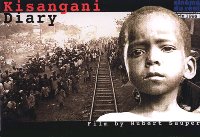
KISANGANIN PÄIVÄKIRJA
"Lapset: ilman vanhempia. Kasvot: ilman toivoa. Ruumiit: ilman hautoja."
 Hubert Sauperin Kisanganin päiväkirja on järkyttävä dokumentti tapahtumista entisen Zairen alueella maalis-huhtikuussa vuonna 1997. YK löytää vanhan rautatien varrelta Kisanganin eteläpuolelta "kadonneita pakolaisia", joita ei enää pitänyt olla olemassa. Nämä 80 000 Ruandan hutua ovat viimeiset, jotka selvisivät hengissä kolmen vuoden nälästä ja aseellisista vainoista sademetsissä kaukana kotoaan. Epätoivoisista auttamisyrityksistä huolimatta pakolaiset eivät vieläkään ole turvassa, sillä vain viikkoja myöhemmin YK:n pystyttämät pakolaisleirit joutuvat tulituksen kohteeksi. Huhtikuisena yönä 1997, noin 80 000 naista, miestä ja lasta joko kuolee tai katoaa jälleen viidakkoon.
Hubert Sauperin Kisanganin päiväkirja on järkyttävä dokumentti tapahtumista entisen Zairen alueella maalis-huhtikuussa vuonna 1997. YK löytää vanhan rautatien varrelta Kisanganin eteläpuolelta "kadonneita pakolaisia", joita ei enää pitänyt olla olemassa. Nämä 80 000 Ruandan hutua ovat viimeiset, jotka selvisivät hengissä kolmen vuoden nälästä ja aseellisista vainoista sademetsissä kaukana kotoaan. Epätoivoisista auttamisyrityksistä huolimatta pakolaiset eivät vieläkään ole turvassa, sillä vain viikkoja myöhemmin YK:n pystyttämät pakolaisleirit joutuvat tulituksen kohteeksi. Huhtikuisena yönä 1997, noin 80 000 naista, miestä ja lasta joko kuolee tai katoaa jälleen viidakkoon.Kisanganin päiväkirja on dokumentti jota kukaan ei halua nähdä, mutta joka oli pakko tehdä ja joka on katsottava. Hubert Sauperin dokumentti kuvaa "unohdetun sodan" uhrien käsittämätöntä todellisuutta ja katsojista tulee sen todistajia.
Kisangain päiväkirja on huomioitu lukuisilla festivaaleilla. Dolby surround, laajakangaselokuva on palkittu Grand Prixillä Cinema du Réel’issä Pariisissa 1998, Centaur for best documentary -palkinnolla Pietarissa 1998. Se on saanut Special Jyry Mention -huomionosoituksen Karlovy Varyssa 1998, Don Quichote Awardin Karakovassa 1998, One World 98 Media Awardin Lontoossa ja Special Jyry Mentionin Berliinissä 1998.
Elokuvan yhteydessä Kakkosella keskiviikkona esitetään Dokumenttiprojektin tuottama Hubert Sauperin lyhyt haastattelu dokumentin toteuttamisesta.
- Ohjaaja: Hubert Sauper
- Tuotanto: Hubert Sauper, Ranska, 1998
In English In English In English
KISANGANI DAIRY
 Hubert Sauber: Why film?
Hubert Sauber: Why film?Naive enough to go to a country in civil war, I wanted to make a documentary about refugees - what it means to be "on the run" and listen to their hard life's stories. Filming eternally moving people became central idea after having been on the heels gypsies, circus-directors and similar "travellers".
What I found in that rotten jungle of Congo were not refugees, but dying or dead human beings, in thousands, who were in no position of talking at all, especially not about their own terrible fate. I became witness of an apocalyptical scenery, indescribable, without having searched it. The horror consisted not primarily of seeing the results of another stupid war, another genocide, but understanding the sheer and growing indifference of "us" towards such disasters. "The main objective is saving human lives" declared the head "emergency officer" of the UN, sitting back relaxed in his white office, a few miles away from where 80.000 were about to starve. (Are we all going nuts, or what?) Experienced war-insiders would say, that's normal. He only does his job. Reporters maybe write down, what he just said, add a new few facts and numbers and then go out to film some victims, as close as possible, to illustrate empty words.
Humanitarian themes never really interested me. It's boring to hear what everybody knows: the world is unjust, statistics don't lie, look at the poor kids with their eyes, dying away all innocent...
But when you look at those big eyes of your brother or sister long enough, their pain might also strike you, and it might never go away anymore. Children: without parents. Faces: without hope. Bodies: without graves. White men walking over black corpses. TV-cameras and rebels: shooting. Shooting into the crowded camps.
To me, making this film was a step too far into the unknown, and I don't know yet how to get back out. Nobody likes to see such pictures, or at least they would have to be well explained by a re-assuring commentary. I don't really know what to say about all that. So the images stand for themselves. All naked and ugly, in the exact chronology of how they happened. I want the spectators to become eye-witnesses themselves - of an unbearable reality of human nature. As a Film maker, I am part of that reality, and I am aware about exposing myself, more than anyone, to criticism. After all, I want people also to find what they don't search.
- Director and producer: Hubert Sauper, France, 1998

Päivitys: 20.8.1998.U.E.